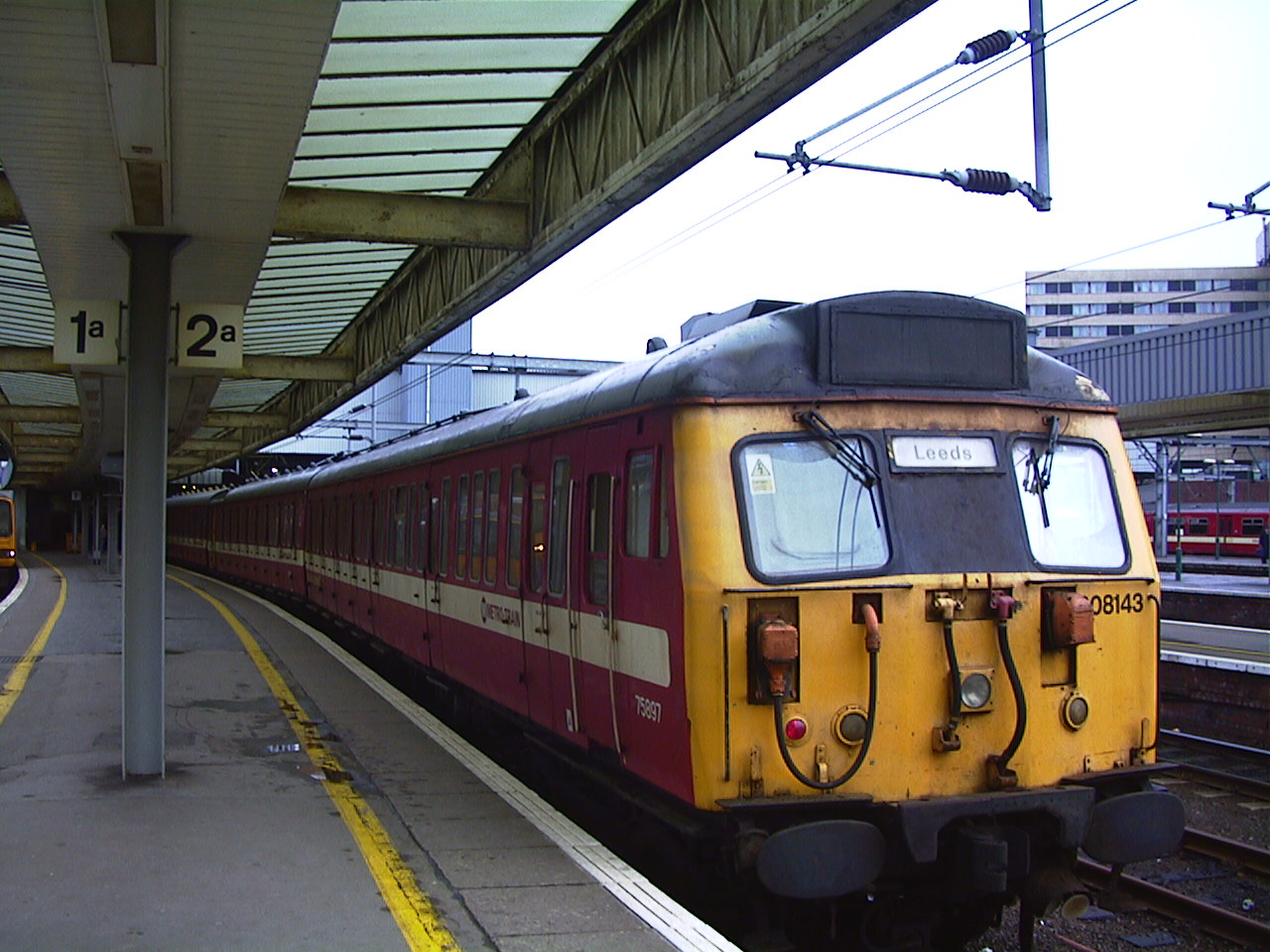- British Rail Class 308
Infobox EMU
name = British Rail Class 308
imagesize = 300px
caption = Class 308 at Leeds station.
background = #012545
Manufacturer = BR York
Operator =British Rail
Formation = 4 cars (308/1 before 1994, 308/2)
3 cars (308/1 after 1994, 308/3)
Refurbishment = 1981–1983, 1994
Built = 45 trainsets
InService = 1961–2001
MaxSpeed = 75mph (121 km/h)
Gauge =Standard gauge (1,435 mm)
Voltage = 25kV AC OverheadTheBritish Rail (BR) Class 308alternating current (AC)electric multiple unit s (EMU) were built by BR atYork , in three batches, from 1961–62. They were initially classified as AM8 units before the introduction ofTOPS .Description
Class 308/1
The first batch of 33 units were built in 1961, numbered 133–165. This was later changed to Class 308/1 under the
TOPS system, and units were renumbered 308133–165. These units were built to operate commuter services on theGreat Eastern Main Line (GEML) fromLondon Liverpool Street toShenfield ,Witham ,Colchester ,Walton-on-the-Naze andClacton . Each unit was formed of four carriages: two outer driving trailers, an intermediate trailer, and a motor coach.From 1981–83, the units were refurbished, which included opening out compartments, fitting of gangways between carriages, and moving first class seating from the intermediate trailer to one of the driving trailers. In this modified form, the technical description of the formation was BDTCOL+MBSO+TSOL+DTSO. Individual carriages were numbered as follows:
*75878-75886 and 75896-75919 - BDTCOL
*61883-61915 - MBSO
*70611-70643 - TSOL
*75887-75895 and 75929-75952 - DTSOClass 308/2
A second batch of nine units, numbered 313–321, were built for boat train services on the
London, Tilbury and Southend Railway in 1962, fromTilbury to London Fenchurch Street. These units were later reclassified as Class 308/2 underTOPS . Each unit was formed of four carriages: two outer driving trailers, an intermediate trailer, and a motor luggage van. The technical description of the formation was BDTS+MLV+TC+DTS. Individual carriages were numbered as follows:
*75920-75928 - BDTS
*68011-68019 - MLV
*70644-70652 - TC
*75953-75961 - DTSWhen Tilbury Docks closed as acruise liner terminal, these units were made redundant and withdrawn from service in 1983. Three units were subsequently rebuilt as Class 308/4 parcels units forRail Express Systems (see below).Class 308/3
Finally, a third batch of 3-car units were built in
1962 forsuburb an services fromLondon Liverpool Street toChingford andEnfield . They were numbered 453–455, following on from the Class 305/1 units, which also operated these services (which were numbered in the range 401–452).These units were later reclassified as Class 308/3, and renumbered 308453–455 under
TOPS . Unlike the first batch, these units contained no first-class seating. Each unit was formed of three carriages: two outer driving trailers, and an intermediate motor coach. The technical description of the unit formation was BDTS+MBS+DTS. Individual carriages numbers were as follows:
*75741-75743 - BDTS
*61689-61691 - MBS
*75992-75994 - DTSThese units were withdrawn in the late 1980s.Converted Postal Units
In 1983, three former Class 308/2 units (nos. 314/319/321) were converted into Class 308/4 postal units by the Parcels sector, with the removal of the intermediate trailer, and renumbered 308991–993. These units were replaced by three converted Class 302/9 parcels units in 1992.
Operations
By the early 1990s, only the Class 308/1 units were still in service. These were gradually replaced on GEML services by the new Class 321 units. Some of the displaced units were transferred to the
London, Tilbury and Southend Railway (LTS), whilst others were transferred to the West Midlands to work commutertrain s pending the introduction of new Class 323 units. The LTS units were later displaced by Class 312 units, but two were retained and converted to Class 937 sandite units.In 1994–95, electrification spread North from
Leeds toBradford ,Skipton andIlkley . As no new stock had been ordered, BR decided to overhaul Class 308 units for use on these services. The work was carried out at Doncaster Works, and involved reducing the unit length to three carriages, with the removal of the intermediate trailers, which were scrapped. The trains were also painted in the attractive West Yorkshire Metro maroon and cream livery.In 1996, with the privatisation of Britain's railway network, the Class 308 fleet passed into the ownership of
Angel Trains and leased to the Regional Railways North East franchise. This was originally operated asNorthern Spirit , but the franchise was later taken over byArriva and operated asArriva Trains Northern .By the late 1990s, it was clear that the elderly Class 308 units needed replacing. Due to their age, they were increasingly unreliable and expensive to maintain. They were replaced by sixteen new 3-car Class 333 units, which were introduced from
2000 . The Class 308 units were withdrawn and sent for storage at MoD Pig's Bay nearShoeburyness . The final three units, nos. 308138/157/158, were withdrawn in late2001 , and were sent for scrap atImmingham . Since then, the stored units have slowly been scrapped at various locations, with the final vehicles disposed of in2004 . However, one driving trailer was saved for preservation.Preservation
One driving trailer from unit 308136 has been saved for preservation.
*75881 - [http://group.acemu.co.uk/ AC EMU Group] atWalthamstow Pump House Museum [http://www.leavalleyexperience.co.uk (website)]The carriage has been stripped of
asbestos and will therefore require a full internal rebuild at some point. This work has been ongoing for 2 years and most of the spares have been obtained, but a compressor, First Class doors and a Toilet door are still required.Fleet details
Wikimedia Foundation. 2010.
